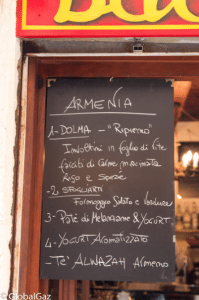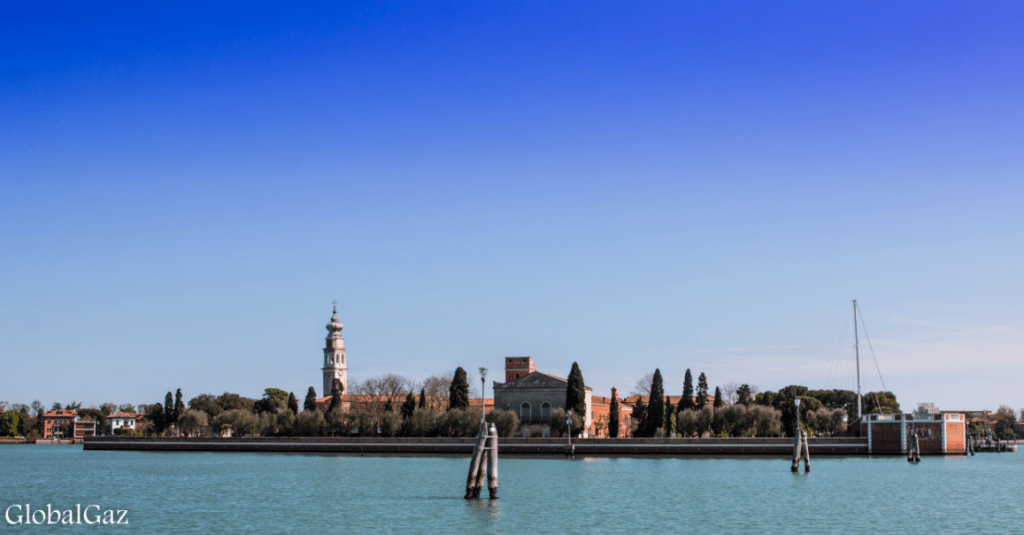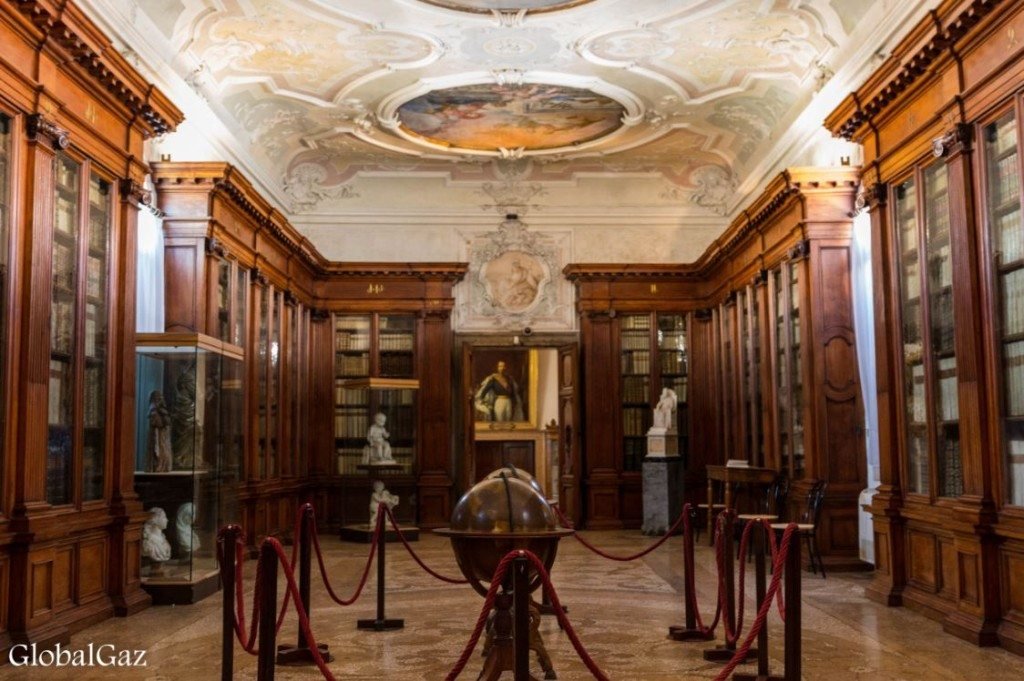Special for the Armenian Weekly
Dolma. I was not expecting that. Nearly 80 percent of the restaurants listed in Trip Advisor in Venice are categorized as Italian. After gobbling pizza and pasta ad infinitum, the last thing I was expecting to see being advertised at the restaurant adjacent to my hotel was homemade dolma.


I poked my head into the restaurant. I stared at the bartender. I knew immediately. “Parev dzez,” I offered. A smile grew on his face. I had just met Bogos Yaghoubian, Venetian resident, originally from Iran. He had ended up in Venice as a student at the Armenian College. After school, he settled in this former city-state. Once a month, Bogos would cook up a fresh batch of dolma as a special at the Italian restaurant.
After learning about Bogos’s background, I followed the map on a 30-minute walk to the Moorat-Raphael College of Venice, which Bogos attended upon arriving in Venice. The college rests on one of Venice’s many canals. The stately structure was built in Baroque style that dates to 1690. The college was funded by two Armenians from India in 1836 and is currently closed.



Of course, with some additional wanderings I discovered two additional Armenian businesses. A luxury leather works store named Serapian. And in the heart of St. Mark’s Square, a jeweler and watchmaker, Tokatzian.
Armenians started arriving in Italy as early as the 6th century, but Armenian communities began to take shape in the 12th and 13th century in Venice. Venice was a powerful city-state that traded throughout the Mediterranean Sea. One of its trading partners was the Armenian Kingdom of Cilicia. Treaties were signed that allowed for Armenians to settle and build businesses in Venice.
In the Armenian community, Venice is best known as home of San Lazzaro degli Armeni. The Venetian Senate ceded this small island in 1717 to allow for the creation of an Armenian monastery that is still in use today. Mkhitar Sebastatsi of Anatolia founded the Mekhitarist Order (named in his honor at his death) in 1701. The order was dedicated to raising the educational and spiritual levels of Armenians. Escaping from persecution in the Ottoman Empire, he and his order had made their way to Venice and established the monastery.

During my recent stay in Venice, I took time to visit this square-shaped island. A quick and efficient vaporetto (water taxi) ride from San Marco brought me to the pier of San Lazzaro. I immediately recognized I was on Armenian terra firma. A blue sailboat stood at attention, appropriately named Armenia with the Armenian cross displayed on the bow. The sign that greeted me on the pier was written in the Armenian alphabet.

My tour started promptly with a multilingual monk who hailed from Syria. And over the next 90 minutes I became acquainted with San Lazzaro degli Armeni. What originally began as a leper colony during the Middle Ages has blossomed into a center of Armenian learning and scholarship. “For more than two centuries this island has been an Armenian oasis transplanted to the Venetian lagoon” wrote the New York Times in 1919. Today, more than 30 residents make their home here, including monks, seminarians, and students.

The monastery has a vast library that was first built in 1740. The library contains more than 150,000 books and periodicals. And it has the third largest collection of Armenian manuscripts numbering 3,000-4,000. The largest collections can be found at the Matenadaran in Yerevan and the Armenian Patriarchate of Jerusalem. The tour was brought to the library to admire some of these ancient works. A publishing house was established in 1789 on the island. In fact, the printing press located here is the oldest continuously operating publishing house in the Armenian world.
The visit came to an abrupt end. I only had moments to catch the last boat to Venice. An Armenian oasis in Venice.






The history of the Armenians in Venice is an important part in the new mystery/thriller about Armenia’s past saving the future of the world: Persona Non Grata: End of the Great Game by Avery Mann, the pen name used by Bruce Janigian. Much of the action takes place on and around San Lazaro, as well as Jerusalem, Echmiadzin and London. The adventure begins in the Vatican with the former Pope Benedict XVI, who was recently presented the book by the president of the European Academy of Sciences and Arts, where Janigian chairs the USA delegation.
Thank you for this information. Looking forward to reading the book. P>S. Great article.
What is the name of the restaurant??? Fantastic photo’s – grazie!
Great article Thanks
We visited this island in 2010. It is so serene and beautiful. We were surprised to learn it is Armenian Catholic. The monks are extremely friendly and knowledgeable. They take the time to talk with and bless you
Now I understand why my husband Hovhannes Pamoukian was always talking about San Lazzaro Monastero Armeno. He is absolutely right to like it where he met lot of friends like Arshavir Terzian, Kevork Sakadjian, Hair Hovsep Behesnelian etc.etc. and until he passed away he had very good communication with his friends. I hope one day to come and visit the Monastry.
I too was fortunate to visit San Lazzaro with my husband years ago with a group of italian and French tourists; we were the only Americans and I the only Armenian..Our guide, a short, humorous, white-haired monk, pinched my cheek and affectionately corrected my Armenian when I identified myself. The library is famous in part because Lord Byron, who spent much time with the Mekhitarist Brothers, and learned the Armenian alphabet, made good use of it.. At the time of our visit, among the treasures that the island was famous for was an Egyptian mummy, which we were shown. Memory doesn’t serve me accurately, but I believe the phenomenon the guide pointed to was that the mummy perspired. The Mekhitarist Brothers are indeed a Catholic order, and are known for their printing press, which is affiliated with another Armenian publisher based in Vienna, perhaps also Mekhitarist. Perhaps someone better informed than I can clarify their relationship to Rome. Meanwhile, thank you for the article and the wonderful photos. It is sad that the Armenian college is defunct. I hope you got to see the streets of the Armenian enclave in Venice, with Armenian children playing and shouting in both Italian and Armenian. Heart-warming.
Beautiful place to visit when in Venice. Don’t miss it!
I was honored to be a student in the Armenian College in Venice form 1979 to 1983. As the writer if this article says the college has been closed as such but the building is being used as a hostel with very affordable prices.
The collegio has wonderful paintings inside the rooms , specially on the first floor where the Concert room is located.
A lot of movies and clips have been shot in this college because it has one of the biggest gardens in Venice.
The Concert room was used to host great cultural events with famous musicians and groups.
If you have the chance to visit Venice, do not hesitate to stay at this hostel which is located just 5 minutes by foot from the Piazzale Roma and 10 minutes from the railway station.
The collegio is still owned by the Mekhitari priests who live in the St. Lazzaro island.
Mekhitarists are Catholic and are under the Pope in Rome. As an eastern rite Catholic Church they enjoy much more everyday autonomy that does the Roman Catholic Church. However, in terms of dogma they are under the pope like the Maronites in Lebanon and the other approx 20 eastern Catholic churches
Check out a book called The Crossing Place by Philip Marsden. I’m Irish but it caused me to visit Armenia and I’m going to Venice soon and he talks about this island.
Venice is my favourite of all the cities I have visited so far. First, a nice thing happened to us at the airport. A handsome man(Benni) standing there with my name in his hands, perfectly on time and ready to take us to the hotel. The second was a help that Benny provides at the reception, cause unfortunately there was no English speaking staff. So I highly recommend you meet & greet service that I booked with On top, I felt strangely at home there and kept being able to lead us to places without using a map. I think it’s my favorite, from the moment it touched my heart. There are three things you can watch forever: fire burning, water falling and other people working, so one becomes accomplished.
In about 1906, my grandfather Arakel Artinian from Egypt was sent to the Armenian boarding school in Venice. He would have been about 13 years old, perhaps. Would there be any record kept of his attendance available in the archives of that school?